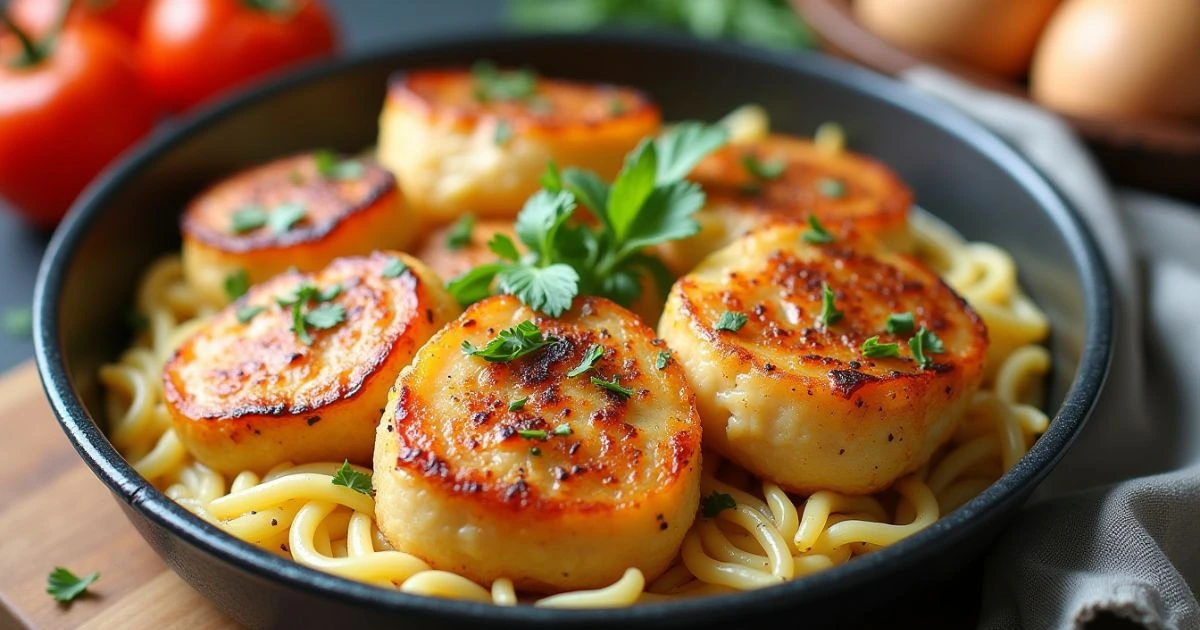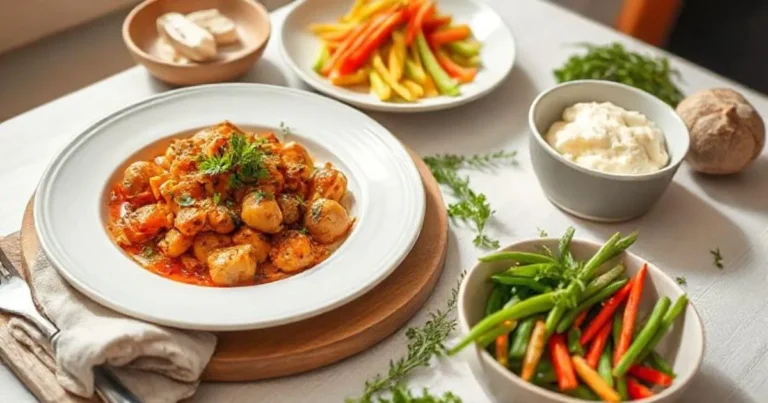The Ultimate Guide to Easy Oven Recipes: Transform Your Kitchen Into a Culinary Haven
Do you remember the first time an incredible aroma filled your kitchen? Picture yourself standing in that warm space, watching through the oven door as something wonderful transforms before your eyes. That magical moment when simple ingredients become extraordinary meals – it’s what draws countless home cooks to embrace oven cooking every single day.
Your journey with oven recipes doesn’t have to feel overwhelming or intimidating. Whether you’re a complete beginner or someone looking to expand your culinary repertoire, the gentle art of oven cooking offers endless possibilities for creating memorable meals that bring people together around your table.
Table of Contents
Why Oven Recipes Are Every Home Cook’s Secret Weapon
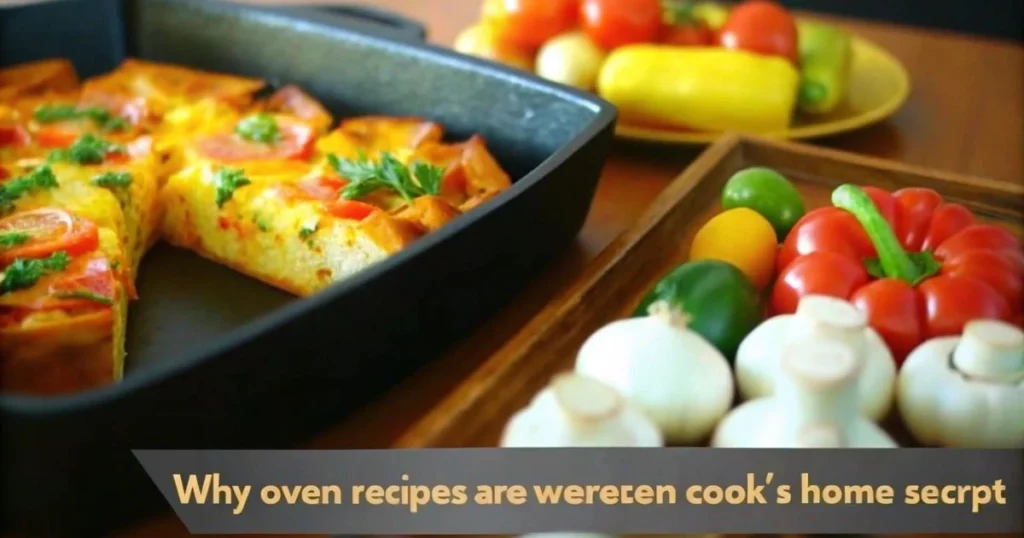
Your oven represents one of the most reliable cooking methods available in your kitchen arsenal. Unlike stovetop cooking that demands constant attention, oven recipes allow you to set, walk away, and return to perfectly cooked results. This hands-off approach transforms your cooking experience from stressful monitoring to confident preparation.
The science behind oven cooking works in your favor through consistent heat distribution. Your oven surrounds food with even temperatures, eliminating hot spots that can burn one side while leaving another undercooked. This reliability makes oven recipes particularly forgiving for newcomers to cooking.
Energy efficiency becomes another compelling reason to master oven recipes. Research indicates that oven cooking uses approximately 30% less energy than multiple burner cooking when preparing complete meals. You can simultaneously cook proteins, vegetables, and sides using various rack positions, maximizing both time and energy usage.
Consider the meal prep advantages that oven recipes provide. Large casserole dishes, sheet pan meals, and batch-cooked proteins set you up for successful weekly meal planning. Your Sunday afternoon oven session can produce enough prepared meals to last through busy weekday evenings.
Essential Oven Cooking Techniques for Perfect Results Every Time
Understanding Your Oven: Temperature, Timing, and Positioning
Your oven’s personality affects every recipe you attempt. Most ovens run 15-25 degrees different from their displayed temperature, making an oven thermometer your most valuable investment. Place this thermometer in different positions throughout your oven to identify hot and cool zones.
Rack positioning strategy significantly impacts your oven recipe success. Upper racks provide intense heat perfect for browning and crisping, while lower positions offer gentler cooking ideal for casseroles and delicate proteins. Center positioning works best for most standard recipes, providing balanced heat exposure.
Preheating patience pays dividends in your final results. Your oven needs 15-20 minutes to reach stable temperatures, and rushing this process leads to uneven cooking. Use preheating time productively by preparing ingredients and organizing your cooking space.
Convection settings change the game entirely for many oven recipes. The circulating air cooks food faster and more evenly, but requires temperature adjustments. Reduce your recipe temperature by 25°F and decrease cooking time by roughly 25% when using convection features.
The Science Behind Perfect Oven Recipes
Understanding the Maillard reaction elevates your oven cooking from good to exceptional. This chemical process occurs when proteins and sugars react under heat, creating those beautiful golden-brown surfaces and complex flavors you crave. Dry surfaces brown better, so pat proteins dry before seasoning.
Moisture retention techniques prevent the dreaded dry dinner syndrome. Covering dishes with foil during initial cooking phases traps steam, keeping ingredients tender. Remove covers during final cooking stages to achieve desired browning and texture contrasts.
Temperature control varies significantly based on ingredient types. Dense vegetables require higher temperatures (400-425°F) to cook through properly, while delicate fish needs gentler heat (350-375°F) to prevent overcooking. Match your temperature choices to ingredient characteristics rather than following blanket rules.
Heat distribution principles guide successful oven recipe execution. Avoid overcrowding pans, which creates steam pockets and prevents proper browning. Leave space between ingredients for air circulation, ensuring even cooking throughout your dish.
Essential tools for oven cooking success:
- Digital probe thermometer for accurate doneness testing
- Heavy-duty sheet pans that won’t warp under high heat
- Glass baking dishes for easy monitoring of casseroles
- Quality oven mitts rated for high temperatures
- Timer with multiple alarms for complex recipes
Breakfast Oven Recipes That Will Transform Your Mornings

Make-Ahead Breakfast Casseroles
Your mornings become infinitely more manageable with prepared breakfast casseroles waiting in your refrigerator. These versatile dishes combine protein, vegetables, and starches into single-pan solutions that feed families without morning chaos.
Classic Sausage and Egg Breakfast Casserole
| Ingredient | Quantity | Notes |
|---|---|---|
| Large eggs | 12 | Room temperature beats easier |
| Whole milk | 2 cups | Creates creamy texture |
| Italian sausage | 1 pound | Brown and drain excess fat |
| Sharp cheddar | 2 cups shredded | Reserve 1/2 cup for topping |
| Day-old bread | 8 cups cubed | Stale bread absorbs better |
| Yellow onion | 1 medium diced | Sauté until translucent |
Your preparation begins the evening before serving. Brown sausage completely, removing excess grease that could make your casserole soggy. Layer bread cubes in your greased baking dish, followed by sausage, onions, and cheese. Whisk eggs with milk, then pour evenly over ingredients. Cover and refrigerate overnight.
Morning cooking requires 45-55 minutes at 350°F. Your casserole is finished when the center springs back lightly when touched, and edges pull slightly from the dish sides. Allow 10 minutes resting time before serving to prevent crumbling.
Vegetarian Spinach and Mushroom Alternative
Transform the base recipe by substituting sausage with sautéed mushrooms and fresh spinach. Add sun-dried tomatoes and feta cheese for Mediterranean flavors that satisfy vegetarian family members without compromising protein content.
Individual Breakfast Portions
Egg muffin cups revolutionize busy morning routines. These portable protein powerhouses cook in standard muffin tins, creating perfectly portioned breakfasts ready for grab-and-go convenience.
Your basic formula combines beaten eggs with milk, cheese, and chosen vegetables. Fill greased muffin cups 3/4 full to prevent overflow during cooking. Bake at 375°F for 18-22 minutes until centers set completely.
Popular flavor combinations:
- Ham, Swiss, and asparagus
- Bacon, cheddar, and jalapeño
- Spinach, feta, and sun-dried tomato
- Turkey sausage, pepper jack, and bell pepper
Lunch and Dinner Oven Recipes for Effortless Family Meals
One-Pan Protein and Vegetable Combinations
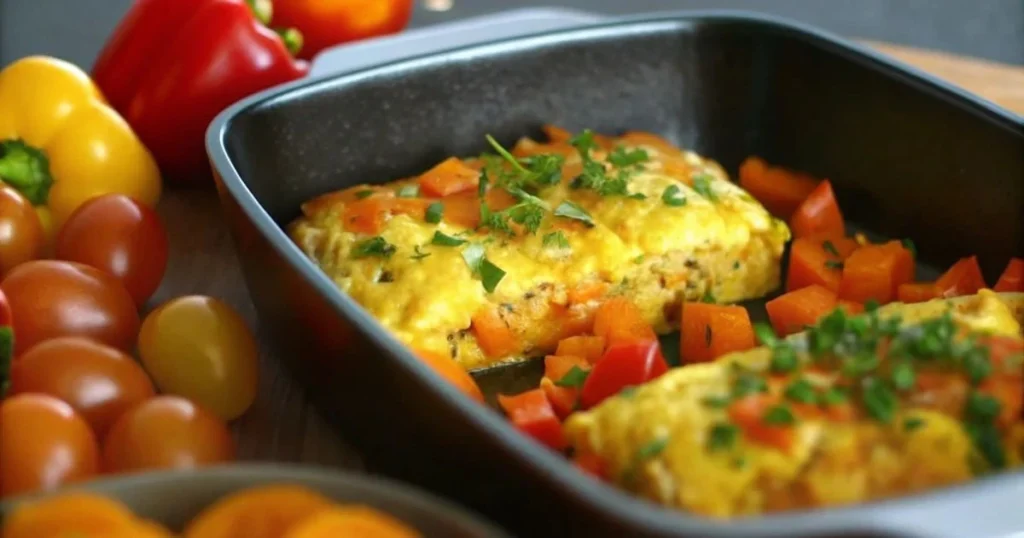
Sheet pan dinners eliminate multiple pot cleanup while delivering complete, balanced meals. Your protein and vegetables roast together, allowing flavors to meld while different cooking times accommodate varying ingredient needs.
Mediterranean Sheet Pan Chicken
Start with chicken thighs, which remain juicy throughout longer cooking times required for vegetables. Season generously with oregano, garlic powder, lemon zest, and olive oil. Arrange on one half of your sheet pan.
Surround chicken with chunked vegetables: red onions, bell peppers, zucchini, and cherry tomatoes. Drizzle vegetables with olive oil and season separately. Different vegetables require staggered addition times for perfect doneness.
Begin roasting at 425°F with chicken and heartier vegetables like onions and peppers. Add tender vegetables like zucchini and tomatoes during the final 15 minutes. Your complete meal finishes in 35-40 minutes total.
Comfort Food Classics Made Easy
Perfect Oven-Baked Mac and Cheese
| Ingredient Category | Ingredient | Quantity | Purpose |
|---|---|---|---|
| Pasta Base | Elbow macaroni | 1 pound | Holds cheese sauce well |
| Cheese Blend | Sharp cheddar | 3 cups shredded | Primary flavor |
| Gruyere | 1 cup shredded | Adds complexity | |
| Sauce Foundation | Butter | 4 tablespoons | Roux base |
| All-purpose flour | 4 tablespoons | Thickening agent | |
| Heavy cream | 2 cups | Rich texture | |
| Seasoning | Dry mustard | 1 teaspoon | Enhances cheese flavor |
| White pepper | 1/2 teaspoon | Heat without color |
Your cheese sauce begins with a proper roux. Melt butter over medium heat, whisk in flour, and cook for 2 minutes to eliminate raw flour taste. Gradually add warm cream, whisking constantly to prevent lumps.
Remove from heat before adding cheese in handfuls, stirring until smooth between additions. Combine with slightly undercooked pasta, transfer to buttered baking dish, and top with reserved cheese.
Bake at 375°F for 25-30 minutes until bubbly and golden. Rest 10 minutes before serving to allow sauce thickening.
International Oven Recipe Adventures
Asian-Inspired Sheet Pan Salmon
Marinate salmon fillets in soy sauce, honey, rice vinegar, and fresh ginger. Arrange alongside snap peas, broccoli, and sliced bell peppers on your sheet pan. Drizzle vegetables with sesame oil and sprinkle with sesame seeds.
Roast at 400°F for 12-15 minutes until salmon flakes easily. Serve over steamed rice with sriracha and lime wedges for customizable heat levels.
Mexican Stuffed Bell Peppers
Hollow bell peppers become edible serving vessels for seasoned ground turkey, rice, black beans, and cheese. Your filling combines cooked rice with browned meat seasoned with cumin, chili powder, and garlic.
Stuff peppers generously, top with cheese, and bake covered at 375°F for 35 minutes. Remove cover for final 10 minutes to brown cheese topping.
Sweet Treats and Dessert Oven Recipes
Beginner-Friendly Baked Desserts
Your dessert confidence builds through mastering foundational recipes that deliver consistent results. Chocolate chip cookies represent the perfect starting point, teaching crucial techniques like proper mixing and recognizing doneness cues.
No-Fail Chocolate Chip Cookie Formula
Room temperature butter creams properly with sugars, creating the tender texture you want. Avoid melted butter, which produces flat, crispy cookies instead of chewy centers. Mix dry ingredients separately before combining to ensure even distribution.
Chill your dough 30 minutes before baking for cookies that hold their shape. Space dough balls 2 inches apart on parchment-lined sheets. Bake at 375°F for 9-11 minutes until edges set but centers appear slightly underdone.
Impressive Desserts That Look Professional
Classic Apple Crisp
| Component | Ingredient | Quantity | Tips |
|---|---|---|---|
| Fruit Base | Granny Smith apples | 6 large | Tart variety holds shape |
| Granulated sugar | 1/2 cup | Adjust for apple sweetness | |
| Ground cinnamon | 2 teaspoons | Fresh ground preferred | |
| Lemon juice | 2 tablespoons | Prevents browning | |
| Crisp Topping | Old-fashioned oats | 1 cup | Avoid quick oats |
| All-purpose flour | 3/4 cup | Binds topping | |
| Brown sugar | 1/2 cup packed | Adds molasses notes | |
| Cold butter | 1/2 cup cubed | Key to crumbly texture |
Slice apples uniformly for even cooking. Toss with sugar, cinnamon, and lemon juice before arranging in buttered baking dish. Your topping combines dry ingredients before cutting in cold butter pieces until mixture resembles coarse crumbs.
Distribute topping evenly over apples. Bake at 375°F for 40-45 minutes until topping browns and fruit bubbles around edges. Serve warm with vanilla ice cream for restaurant-quality presentation.
Meal Prep Mastery: Oven Recipes for Busy Lifestyles
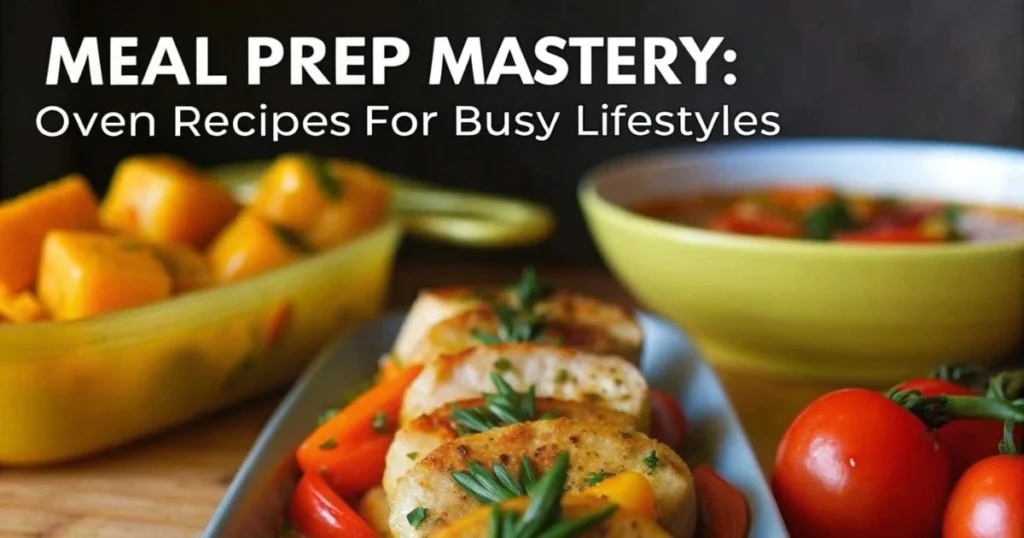
Batch Cooking Strategies
Your weekend oven sessions set the foundation for stress-free weeknight dinners. Focus on versatile proteins and grain-based dishes that reheat beautifully and adapt to different flavor profiles throughout the week.
Invest in quality glass containers that transition safely from freezer to oven to microwave. Label everything with contents and date to maintain food safety and prevent mystery meals lurking in your freezer.
Freezer-friendly oven recipe modifications:
- Slightly undercook vegetables to prevent mushiness after reheating
- Use less liquid in casseroles since frozen ingredients release moisture
- Assemble unbaked casseroles and freeze before cooking for freshest results
- Double-wrap everything to prevent freezer burn
Weekly Meal Prep Schedule
Sunday afternoon timeline:
- 2:00 PM: Preheat oven, prep all vegetables
- 2:30 PM: Start longest-cooking items (roasts, whole chickens)
- 3:30 PM: Add sheet pan vegetables to second oven rack
- 4:00 PM: Prepare grain salads and quick-cooking proteins
- 5:00 PM: Package and label completed meals
Your storage system should accommodate different reheating needs. Individual portions work best for lunches, while family-sized containers suit weeknight dinners. Keep raw and cooked items separated to maintain food safety.
Troubleshooting Common Oven Recipe Challenges
Temperature and Timing Issues
Overcooked exteriors with raw centers typically indicate excessive temperature. Lower your heat by 25°F and extend cooking time to allow gentle heat penetration. Cover dishes with foil if browning occurs too quickly.
Uneven browning patterns suggest oven hot spots or overcrowded pans. Rotate dishes halfway through cooking and ensure adequate spacing between items. Consider using light-colored pans which heat more gently than dark surfaces.
Dry textures result from overcooking or insufficient moisture. Use meat thermometers to prevent overcooking proteins. Add liquid ingredients like broth or wine to casseroles during cooking if they appear too dry.
Ingredient Substitutions That Work
Emergency substitution guide:
| Missing Ingredient | Substitute | Ratio | Results |
|---|---|---|---|
| Heavy cream | Half-and-half + butter | 1 cup + 2 tbsp butter | Nearly identical richness |
| Brown sugar | White sugar + molasses | 1 cup + 1 tbsp molasses | Authentic flavor match |
| Buttermilk | Milk + vinegar | 1 cup milk + 1 tbsp vinegar | Let sit 5 minutes |
| Cake flour | All-purpose flour + cornstarch | 1 cup – 2 tbsp flour + 2 tbsp cornstarch | Lighter texture |
Seasonal Oven Recipes: Cooking with Nature’s Calendar
Spring and Summer Light Oven Meals
Warmer months call for recipes that won’t heat up your entire kitchen. Focus on shorter cooking times and fresh ingredient combinations that celebrate seasonal produce.
Herb-crusted fish fillets cook quickly at high heat, developing crispy exteriors while maintaining flaky interiors. Surround with asparagus, new potatoes, and cherry tomatoes for complete spring meals ready in 25 minutes.
Stone fruit desserts capture summer’s sweetness without lengthy baking times. Peach and blueberry galettes cook in individual portions, reducing oven time while creating elegant presentations.
Fall and Winter Comfort Oven Recipes
Colder months invite longer braising and slow-roasting techniques that fill your home with warming aromas. Root vegetables develop incredible sweetness through extended roasting, while tough meat cuts become fall-apart tender.
Moroccan-Spiced Root Vegetable Medley
Combine carrots, parsnips, sweet potatoes, and red onions with warming spices like cinnamon, cumin, and paprika. Roast at 425°F for 35-40 minutes, stirring once halfway through cooking.
Hearty grain casseroles incorporating farro, wild rice, or barley provide satisfying sustenance during cold weather. These dishes improve overnight, making them perfect for entertaining or meal preparation.
Budget-Friendly Oven Recipes That Don’t Skimp on Flavor
Affordable Protein Solutions
Your grocery budget stretches further with less expensive cuts that shine through slow oven cooking. Chicken thighs cost significantly less than breasts while delivering superior flavor and moisture retention.
Pork shoulder transforms into succulent pulled pork through low, slow roasting. Season generously, cook at 275°F for 6-8 hours, and shred for multiple meal applications throughout the week.
Versatile lentil and vegetable casseroles provide complete proteins at fraction of meat costs. Combine green lentils with seasonal vegetables, vegetable broth, and herbs for satisfying meatless meals.
Maximizing Ingredients Across Multiple Meals
Your roasted chicken becomes three distinct meals through creative repurposing. Serve fresh on day one, transform leftovers into chicken salad, and simmer bones for homemade stock.
Base vegetable mixtures adapt to different cuisines through spice variations. Mediterranean herbs create Greek flavors, while curry powder transforms the same vegetables into Indian-inspired dishes.
Smart shopping strategies:
- Buy proteins on sale and freeze in recipe-sized portions
- Purchase vegetables at peak season and preserve through roasting and freezing
- Stock up on pantry staples during sales to reduce per-meal costs
- Plan recipes around store circular specials
Frequently Asked Questions About Oven Recipes
What are the best oven recipes for beginners?
Start your oven cooking journey with forgiving sheet pan oven recipes featuring chicken thighs and sturdy vegetables. These recipes tolerate timing variations while teaching fundamental techniques. Simple baked pasta dishes and basic cookies build confidence through reliable success rates.
How do I prevent my oven recipes from drying out?
Moisture retention requires strategic approach combining proper temperatures, adequate liquid content, and careful timing. Use meat thermometers to avoid overcooking proteins. Cover dishes with foil during initial cooking phases, removing covers only for final browning. Choose recipes with sufficient fat content from ingredients like cheese, olive oil, or butter.
Can I double most oven recipes for larger families?
Most oven recipes scale successfully with proper adjustments. Use larger baking dishes or multiple pans to accommodate increased quantities. Increase cooking time by 15-25% while checking doneness frequently during final stages. Ensure even heat distribution by rotating pans and avoiding overcrowding.
What’s the difference between convection and regular oven settings for recipes?
Convection oven recipe modifications include reducing temperature by 25°F from standard recipe instructions and decreasing cooking time by approximately 25%. Use convection settings for crispy textures and even browning results. Stick to regular settings for delicate baked goods that might be disrupted by circulating air.
How do I convert stovetop recipes to oven recipes?
Successful conversions start with 325°F-350°F temperatures for most dishes. Use oven-safe cookware like cast iron or ceramic vessels. Add liquid to prevent drying, and cover tightly to replicate steaming effects. Test frequently until you understand timing differences between cooking methods.
What are the most essential tools for successful oven recipes?
Must-have equipment includes:
- Accurate oven thermometer for temperature verification
- Various sized sheet pans for different recipe scales
- Glass or ceramic baking dishes for easy monitoring
- Instant-read thermometer for doneness testing
- Multiple timer system for complex recipes
- Quality oven mitts rated for high temperatures
- Cooling racks for proper finishing
How long can I safely keep prepared oven recipes in the refrigerator?
Storage timeline for oven recipes:
- Cooked casseroles and baked dishes: 3-4 days maximum
- Baked proteins like chicken or fish: 3-4 days
- Baked desserts: varies by ingredients (2-7 days typically)
- Store everything in airtight containers with preparation dates labeled
Why do my oven recipes cook unevenly?
Uneven cooking results from oven hot spots, overcrowded pans preventing air circulation, incorrect rack positioning, or frequent door opening that disrupts temperature stability. Use oven thermometer placement to identify problem areas. Dark-colored pans absorb more heat than light surfaces, affecting cooking patterns.
Transform Your Kitchen Today
Your culinary adventure with oven recipes begins with a single dish that speaks to you. Whether you choose a comforting breakfast casserole, an impressive sheet pan dinner, or a soul-warming dessert, each success builds confidence for your next kitchen triumph.
Remember that every expert cook started exactly where you are now – with curiosity, willingness to learn, and the desire to create something wonderful for the people they care about. Your oven stands ready to help you craft those magical moments that bring families together and create lasting memories.
Take action today: Choose one recipe from this guide that excites you most. Gather your ingredients, preheat your oven, and trust the process. Your kitchen transformation awaits, and the aromatic rewards will remind you why oven cooking remains one of life’s greatest simple pleasures.
Share your oven recipe successes with friends and family. The gift of delicious, homemade food creates connections that extend far beyond your kitchen walls. Your newfound confidence with oven recipes will inspire others to begin their own culinary journeys, spreading the joy of home cooking one perfectly baked dish at a time.
Did You Try Our Recipe ?
There are no reviews yet. Be the first one to write one.

